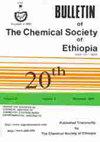Manganese oxide-coffee husk and khat (Catha edulis) leftover biochar nanocomposites for removal of Cr(VI) from wastewater
IF 1.3
4区 化学
Q3 CHEMISTRY, MULTIDISCIPLINARY
引用次数: 0
Abstract
This study investigates the use of manganese oxide-biochar-nanocomposites synthesized from coffee husk (CH) and khat leftover (KL) for Cr(VI) removal from water. Two pristine biochars of CH and KL were separately synthesized by pyrolyzing their biomasses at 300 ℃ for 1 h. Similarly, biochar-based nanocomposites were synthesized by pretreating 25 g of each biomass with 12.5 mmol of KMnO4 and pyrolyzing at 300 ℃ for 1 h. The pristine biochars, synthesized by pyrolysis of CH and KL, removed 74.98% and 84.78% of Cr(VI) from aqueous solutions containing 20 mg L-1, respectively. However, the resulting nanocomposites exhibited a maximum removal efficiency of 99.63% with manganese oxide-coffee husk biochar nanocomposite (MnOX-CHBNC) and 99.84% with manganese oxide-khat leftover biochar nanocomposite (MnOX-KLBNC) of the Cr(VI). The adsorption isotherm fitted well with the Langmuir isotherm, indicating favorable monolayer adsorption. The kinetics of adsorption followed the pseudo-first-order model. The MnOX-CHBNC and MnOX-KLBNC demonstrated satisfactory removal efficiencies even up to six cycles, indicating their potential effectiveness for large-scale use in removing Cr (VI) from wastewater. KEY WORDS: Adsorption, Biochar-nanocomposite, Coffee husk, Cr(VI) removal, Khat leftovers Bull. Chem. Soc. Ethiop. 2024, 38(5), 1225-1240. DOI: https://dx.doi.org/10.4314/bcse.v38i5.3氧化锰-咖啡壳和阿拉伯茶叶(Catha edulis)残渣生物炭纳米复合材料用于去除废水中的六(Cr(VI))铬
本研究调查了利用咖啡壳(CH)和阿拉伯茶残渣(KL)合成的氧化锰生物炭纳米复合材料去除水中六价铬的情况。通过在 300 ℃ 下热解这两种生物质 1 小时,分别合成了 CH 和 KL 的两种原始生物炭。通过热解 CH 和 KL 合成的原始生物炭可从 20 mg L-1 的水溶液中分别去除 74.98% 和 84.78% 的六价铬。然而,氧化锰-咖啡渣生物炭纳米复合材料(MnOX-CHBNC)和氧化锰-咖啡渣生物炭纳米复合材料(MnOX-KLBNC)对六价铬的去除率分别达到了 99.63% 和 99.84%。吸附等温线与 Langmuir 等温线非常吻合,表明单层吸附效果良好。吸附动力学遵循伪一阶模型。MnOX-CHBNC 和 MnOX-KLBNC 的去除率令人满意,甚至可以达到六个循环,这表明它们在大规模去除废水中的六(Cr)方面具有潜在的有效性。关键词:吸附、生物炭-纳米复合材料、咖啡壳、六价铬去除、阿拉伯茶叶残渣 Bull.Chem.Soc.2024, 38(5), 1225-1240. DOI: https://dx.doi.org/10.4314/bcse.v38i5.3
本文章由计算机程序翻译,如有差异,请以英文原文为准。
求助全文
约1分钟内获得全文
求助全文
来源期刊
CiteScore
2.20
自引率
8.30%
发文量
113
审稿时长
6-12 weeks
期刊介绍:
The Bulletin of the Chemical Society of Ethiopia (BCSE) is a triannual publication of the Chemical Society of Ethiopia. The BCSE is an open access and peer reviewed journal. The BCSE invites contributions in any field of basic and applied chemistry.

 求助内容:
求助内容: 应助结果提醒方式:
应助结果提醒方式:


